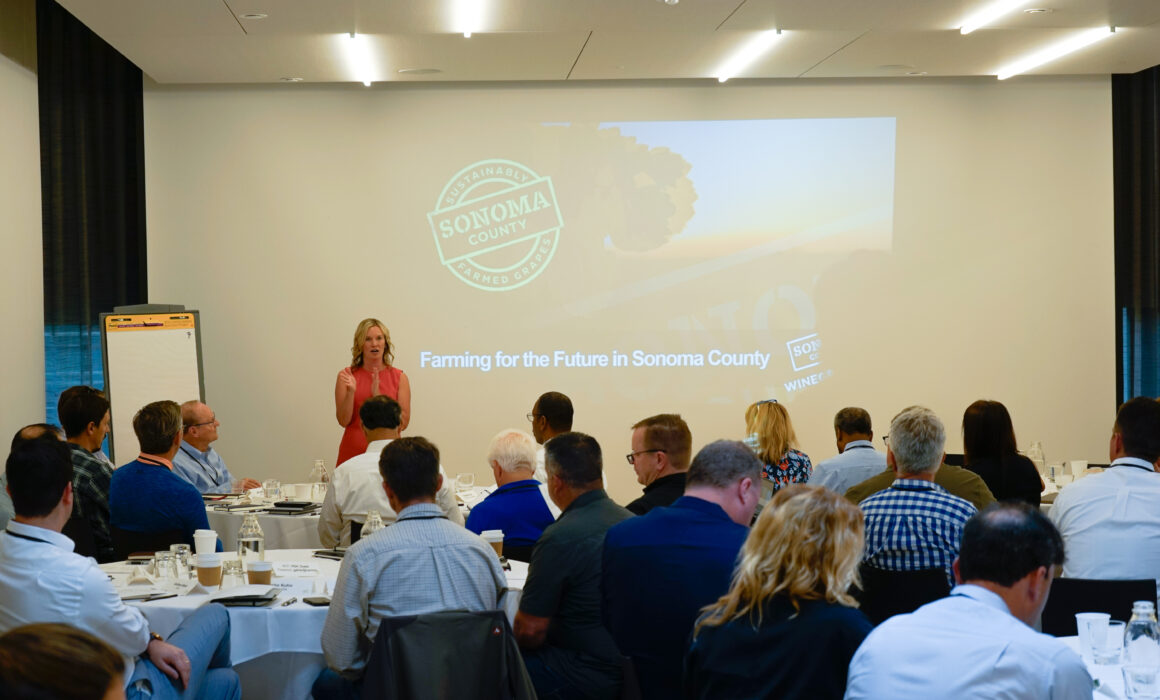What is a Farm of the Future?
By Virginie Boone
What will it take to continue farming in the future? How can agricultural shareholders develop resiliency and sustainability to confront the challenges of the present and future? What will it take to innovate and adapt?
These questions and more were up for discussion as thought leaders from around the United States convened in Sonoma County last week for the first-ever Farm of the Future Summit hosted by the Sonoma County Winegrowers.
These leaders were invite-only and came from such forward-thinking companies as John Deere, American AgCredit, Jordan Energy, Alaska Airlines, Wells Fargo, Agrology, Wilbur-Ellis and Pellenc, with impactful discussions led by Professor Emeritus George Day of the Wharton School of the University of Pennsylvania.
The invitation to participants was clear – to bring their best thinking and ideas to work towards solutions that have real benefit to Sonoma County winegrowers, agriculture and beyond.
This was the SCW’s “man to the moon” call to action, a leveraging of the organization’s leadership in sustainability and its desire to keep moving forward and find real, meaningful solution-based collaboration to support the future of agriculture, technology and climate stewardship.
It was in 2014 that the SCW committed to being 100% certified sustainable in all its vineyard acres. A year later it drafted a 100-year roadmap to preserve agriculture here. In 2017 it launched the Center for Ag Sustainability, a think tank to support long-term agriculture in Sonoma County.
In 2019, 99% of Sonoma County’s vineyard acres became certified sustainable, which led to a partnership with the California Land Stewardship to pilot the first Climate Adaptation Certification for agriculture. All of this activity has now culminated in the Farm of the Future innovation accelerator.
The SCW’s partnership last year with Ford Pro to offer electrification for farming through Ford electric vehicles helped to create an innovative path for SCW to think about other types of collaboration and other partners in sustainability, another step forward to the Farm of the Future.
The Farm of the Future is in fact a living lab for innovating and partnerships, a way of playing offense against farming’s challenges, rather than defense. Sonoma County’s unique profile as a winegrowing region built primarily on multigenerational family businesses is an asset for trying new things – these families are invested more than anyone else in their futures.
Sonoma County’s range of wine grape varieties that it grows – more than 100 and counting – is also interesting, a wide canvas for trialing and adapting to environmental and consumer pressures and preferences. Pilot programs with growers here can cover an array of test subjects.
Partners are needed to tackle many areas of concern. Within the area of climate mitigation and adaptation there is the need for electrification and solar, strategic vineyard planning, water optimization, building soil organic matter, nitrogen accounting, reducing till and mow passes and soil compaction, composting instead of burning, reducing off-site soil and water losses, plant tissue and soil nutrient analyses.
But of course there are always unexpected conditions effecting farmers, from drought to frost to labor and regulations.
The goal with Farm of the Future is to be able to respond faster to climate and marketplace impacts, pilot opportunities that can be scaled and shared, use data and technology to support best practices, and progress toward an ESG scorecard for agriculture.
A follow-up to last week’s summit will include case studies and white papers documenting processes and recommendations for moving forward. The summit has now also created a collaborative network of climate stewards and forward-thinking change agents thinking about Sonoma County agriculture, with the shared desire for innovation to happen faster and more efficiently.
The future of farming is one of the most important conversations impacting the world today, the future of our food source, national security, open space, working lands, sustainability and climate stewardship. Sonoma County should be proud of its leadership role in this ambitious endeavor.


